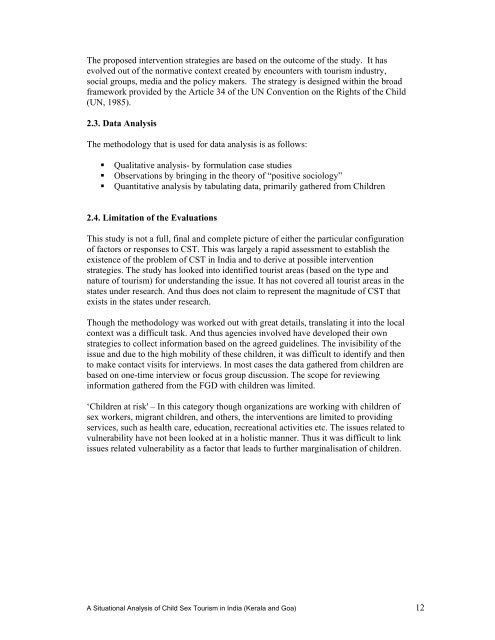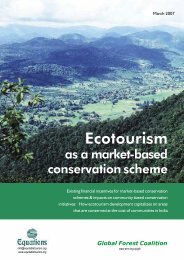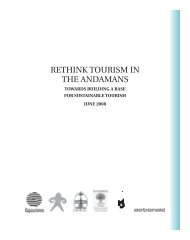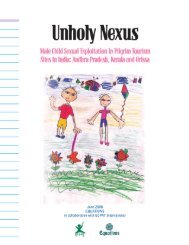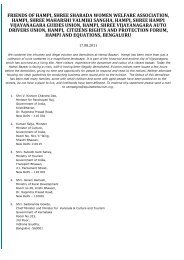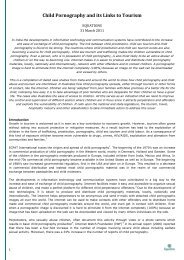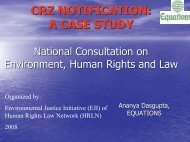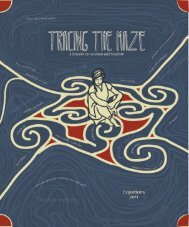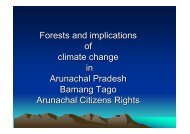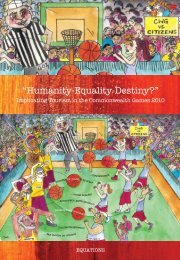The proposed intervention strategies are based on the outcome <strong>of</strong> the study. It hasevolved out <strong>of</strong> the normative context created by encounters with tourism industry,social groups, media and the policy makers. The strategy is designed within the broadframework provided by the Article 34 <strong>of</strong> the UN Convention on the Rights <strong>of</strong> the <strong>Child</strong>(UN, 1985).2.3. Data <strong>Analysis</strong>The methodology that is used for data analysis is as follows:• Qualitative analysis- by formulation case studies• Observations by bringing in the theory <strong>of</strong> “positive sociology”• Quantitative analysis by tabulating data, primarily gathered from <strong>Child</strong>ren2.4. Limitation <strong>of</strong> the EvaluationsThis study is not a full, final and complete picture <strong>of</strong> either the particular configuration<strong>of</strong> factors or responses to CST. This was largely a rapid assessment to establish theexistence <strong>of</strong> the problem <strong>of</strong> CST in India and to derive at possible interventionstrategies. The study has looked into identified tourist areas (based on the type andnature <strong>of</strong> tourism) for understanding the issue. It has not covered all tourist areas in thestates under research. And thus does not claim to represent the magnitude <strong>of</strong> CST thatexists in the states under research.Though the methodology was worked out with great details, translating it into the localcontext was a difficult task. And thus agencies involved have developed their ownstrategies to collect information based on the agreed guidelines. The invisibility <strong>of</strong> theissue and due to the high mobility <strong>of</strong> these children, it was difficult to identify and thento make contact visits for interviews. In most cases the data gathered from children arebased on one-time interview or focus group discussion. The scope for reviewinginformation gathered from the FGD with children was limited.‘<strong>Child</strong>ren at risk' – In this category though organizations are working with children <strong>of</strong>sex workers, migrant children, and others, the interventions are limited to providingservices, such as health care, education, recreational activities etc. The issues related tovulnerability have not been looked at in a holistic manner. Thus it was difficult to linkissues related vulnerability as a factor that leads to further marginalisation <strong>of</strong> children.A <strong>Situational</strong> <strong>Analysis</strong> <strong>of</strong> <strong>Child</strong> <strong>Sex</strong> <strong>Tourism</strong> in India (Kerala and Goa) 12
3. Incidence and Prevalence“In public discourse child sex tourism is not considered a major social issue in India,partly because <strong>of</strong> the perception that the problem is not as acute as in some countries <strong>of</strong>South East Asia and partly because the problem is largely associated only with poverty.The social acceptability <strong>of</strong> having sex with a ‘minor’ is largely ignored because largescalechild marriage still takes place. In addition, women from a number <strong>of</strong> socialgroups are considered ‘inferior’ and their sexual exploitation is not considered as‘something wrong’ in a portion <strong>of</strong> Indian society. The women and girls <strong>of</strong> Dalit andAdivasi communities are termed as ‘ loose’ and therefore free for all to sexually exploit.The perception <strong>of</strong> the Indian society about commercial sexual exploitation <strong>of</strong> childrenis largely governed by the ‘poverty syndrome’.”(Gathia)Commercial sexual exploitation is currently expressed through four modalities. Thesecategories are not mutually exclusive.<strong>Child</strong> prostitution,<strong>Child</strong> pornography,<strong>Sex</strong> tourism andTrafficking <strong>of</strong> children for sexual purposes.According to Davidson and Taylor it is virtually unfeasible to provide accurate figureson the numbers <strong>of</strong> foreign sex tourists visiting any given location. She mentioned thatwhilst there is a problem <strong>of</strong> tourist sexual exploitation in Goa, the state has certainlynothing yet so far witnessed mass western sex tourism. However, at the same time it isimportant to realize that considering the current situation mass sex tourism can developvery rapidly in Goa. Thus, making it very important to examine the factors, which arelikely to promote or discourage this development in Goa.In the 1990s adult as well as child prostitution activities increased and become morevisible and evident through out the country. A number <strong>of</strong> reports appeared in the mediaregarding remunerated sexual relations, although the extent <strong>of</strong> child sex tourism is notyet known, there is enough evidence which points towards its existence in India.<strong>Sex</strong> tourism involving foreigners or local nations and boys and girls and adolescents, itis a phenomenon that has never been broached or investigated in the broader concept <strong>of</strong>CSEC. In port towns like Goa, Kerala, Vizakhapattnam, Kolkatta, Mumbai, Margoa,Mangalore, Cochin, Channai etc adults can be seen with children. Yet it has not yetbeen possible to determine whether these clients are preferential or occasional abusers.The tourist cities <strong>of</strong> India report high levels <strong>of</strong> sex tourism consisting <strong>of</strong> sailors, portemployees and local tourists. Although so far the popular image <strong>of</strong> paedophiles ismostly <strong>of</strong> a potbellied foreigner. However, this kind <strong>of</strong> sexual exploitation is made up<strong>of</strong> local nationals from other parts <strong>of</strong> the country. Goa, Kerala and Kolkatta are reportedto be favourite places <strong>of</strong> foreign paedophiles. The media has also reported theirpresence in these areas.As in the case <strong>of</strong> sex tourism, pornography –which implies the use <strong>of</strong> boys, girls andadolescents in visual or auditory representation for the sexual pleasure <strong>of</strong> the user, hasA <strong>Situational</strong> <strong>Analysis</strong> <strong>of</strong> <strong>Child</strong> <strong>Sex</strong> <strong>Tourism</strong> in India (Kerala and Goa) 13
- Page 1 and 2: A Situational Analysis of Child Sex
- Page 3 and 4: 4.5.1. Articles from theConvention
- Page 5 and 6: INTRODUCTIONThe sexual abuse and ex
- Page 7 and 8: y tourists and ways to combat the p
- Page 9 and 10: where an unbridled tourism is often
- Page 11: overview of their perception and th
- Page 15 and 16: impacts of tourism, it attempted to
- Page 17 and 18: exploitation of children in India a
- Page 19 and 20: connections, and badly maintained r
- Page 21 and 22: Reading the DTV, one wishes there a
- Page 23 and 24: 3.3.2.8. Objective: 12There is no m
- Page 25 and 26: 4. INTERVIEWS4.1. NGOsRespondents:
- Page 27 and 28: Another reason that came up quite s
- Page 29 and 30: The diagram below is developed with
- Page 31 and 32: An ILO report warned that tourists
- Page 33 and 34: existence of CST inKovalam and said
- Page 35 and 36: othel owners go uncharged. In this
- Page 37 and 38: and 15. They could not even sign th
- Page 39 and 40: Working in PartnershipIn Goa, touri
- Page 41 and 42: Reaction of a foreign tourist, who
- Page 43 and 44: Though there are no registered case
- Page 45 and 46: An interview of such children revea
- Page 47 and 48: 6. PUSH AND PULL FACTORSThis covers
- Page 49 and 50: Migration also contributes in makin
- Page 51 and 52: connected with our children. I do n
- Page 53 and 54: on streets”. (Mamata, 20 years ol
- Page 55 and 56: Freddy Peats’ Gurukul:• In 1982
- Page 57 and 58: 7.1.1.7. EducationA majority of chi
- Page 59 and 60: If these people are living in priva
- Page 61 and 62: 8.3. NGOs1. Developing watchdog cel
- Page 63 and 64:
APPENDICESi. Relevant NGOs in Keral
- Page 65 and 66:
First Name Last Name Job Title Orga
- Page 67 and 68:
Though the State of Goa tried to pl
- Page 69 and 70:
ECM: 63 years, ECM from New Zealand
- Page 71 and 72:
Reports1. Advani, P., Impact of Tou
- Page 73 and 74:
Newspaper Clippings:1. Almeida, A.,
- Page 75:
3. Bandhu, P., Kovalam - A Paradise


